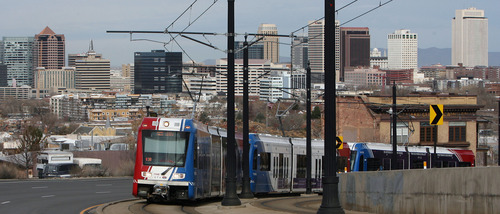This is an archived article that was published on sltrib.com in 2013, and information in the article may be outdated. It is provided only for personal research purposes and may not be reprinted.
Walkable communities. Bicycle lanes. Mass transit. Accessible public spaces. Planning that incorporates environmentalism.
It sounds like the antithesis of suburban sprawl along the Wasatch Front and across America. It also seems to mirror aspects of Salt Lake City Mayor Ralph Becker's agenda.
Some call the progressive design movement being adopted in some American cities "the new urbanism." From Wednesday to June 1, Salt Lake City will be the epicenter of such planning strategies as the Congress for the New Urbanism (CNU) — founded in 1993 — lands downtown for its annual convention.
About 1,200 attendees from across the United States, Canada, Central and South America, Europe, Australia, and even China are expected to attend the confab at the Grand America Hotel. Many of them are interested in seeing the dramatic changes to Salt Lake City's urban landscape, including light rail and walkability, according to a statement from CNU organizers.
Planning philosophies that came to be known as the new urbanism arose in the 1980s, at the height of sprawl. The new urbanism harks back to design standards that were prevalent until cars and highways began dominating development in the early 1960s. It encompasses principles such as traditional neighborhood design and transit-oriented development.
So, why is CNU coming to Salt Lake City?
John Norquist, the former mayor of Milwaukee who now heads up the CNU, said in a February visit to Utah that Salt Lake City has a lot to offer in terms of new urbanism. It was selected to host the organization's 21st annual meeting because of its commitment to new urbanism, the revitalization of downtown and the fact that the area has the fastest-growing light rail system in the country.
"It is all very dramatic, a very vibrant, urban place," he said on the organization's website, noting that Goldman Sachs has located its fourth-largest global operation in Salt Lake City, behind only New York, New Jersey and London.
According to CNU spokesman Tim Halbur, this year's meeting is unique in that it has dedicated an entire track of meetings and events to Salt Lake City, with local speakers and urbanists (including renowned urbanists Reid Ewing and Arthur C. Nelson, both of the University of Utah), and guided tours of Daybreak, City Creek and Olympic Park that will highlight the region's successful planning efforts.
In addition, Envision Utah will get the spotlight for transforming the culture of regional planning in Utah, and influencing numerous other regions in the U.S.
Meetings also will focus on "Environment-Sustainability." According to CNU's spokesman, "the Salt Lake Valley faces increasing challenges related to growth, including environmental management questions as well as how to sustain economic capacity."
For a schedule of speakers, panels and events, as well as registration and ticket information visit http://www.cnu21.org.



